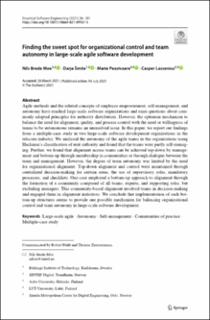| dc.contributor.author | Moe, Nils Brede | |
| dc.contributor.author | Smite, Darja | |
| dc.contributor.author | Paasivaara, Maria | |
| dc.contributor.author | Lassenius, Casper | |
| dc.date.accessioned | 2022-04-29T08:41:56Z | |
| dc.date.available | 2022-04-29T08:41:56Z | |
| dc.date.created | 2021-11-08T22:39:01Z | |
| dc.date.issued | 2021 | |
| dc.identifier.citation | Empirical Software Engineering. 2021, 26, 101. | en_US |
| dc.identifier.issn | 1382-3256 | |
| dc.identifier.uri | https://hdl.handle.net/11250/2993343 | |
| dc.description.abstract | Agile methods and the related concepts of employee empowerment, self-management, and autonomy have reached large-scale software organizations and raise questions about commonly adopted principles for authority distribution. However, the optimum mechanism to balance the need for alignment, quality, and process control with the need or willingness of teams to be autonomous remains an unresolved issue. In this paper, we report our findings from a multiple-case study in two large-scale software development organizations in the telecom industry. We analysed the autonomy of the agile teams in the organizations using Hackman’s classification of unit authority and found that the teams were partly self-managing. Further, we found that alignment across teams can be achieved top-down by management and bottom-up through membership in communities or through dialogue between the team and management. However, the degree of team autonomy was limited by the need for organizational alignment. Top-down alignment and control were maintained through centralized decision-making for certain areas, the use of supervisory roles, mandatory processes, and checklists. One case employed a bottom-up approach to alignment through the formation of a community composed of all teams, experts, and supporting roles, but excluding managers. This community-based alignment involved teams in decision-making and engaged them in alignment initiatives. We conclude that implementation of such bottom-up structures seems to provide one possible mechanism for balancing organizational control and team autonomy in large-scale software development. | en_US |
| dc.language.iso | eng | en_US |
| dc.publisher | Springer | en_US |
| dc.relation.uri | https://link.springer.com/article/10.1007/s10664-021-09967-3 | |
| dc.rights | Navngivelse 4.0 Internasjonal | * |
| dc.rights.uri | http://creativecommons.org/licenses/by/4.0/deed.no | * |
| dc.subject | Large-scale agile | en_US |
| dc.subject | Autonomy | en_US |
| dc.subject | Self-management | en_US |
| dc.subject | Communities of practice | en_US |
| dc.subject | Multiple-case study | en_US |
| dc.title | Finding the Sweet Spot for Organizational Control and Team Autonomy in Large-Scale Agile Software Development | en_US |
| dc.type | Peer reviewed | en_US |
| dc.type | Journal article | en_US |
| dc.description.version | publishedVersion | en_US |
| dc.rights.holder | © The Author(s) 2021. This article is licensed under a Creative Commons Attribution 4.0 International License. To view a copy of this licence, visit http://creativecommons.org/licenses/by/4.0/. | en_US |
| dc.source.volume | 26 | en_US |
| dc.source.journal | Empirical Software Engineering | en_US |
| dc.identifier.doi | 10.1007/s10664-021-09967-3 | |
| dc.identifier.cristin | 1952573 | |
| dc.relation.project | Norges forskningsråd: 267704 | en_US |
| dc.source.articlenumber | 101 | en_US |
| cristin.ispublished | true | |
| cristin.fulltext | original | |
| cristin.qualitycode | 2 | |

